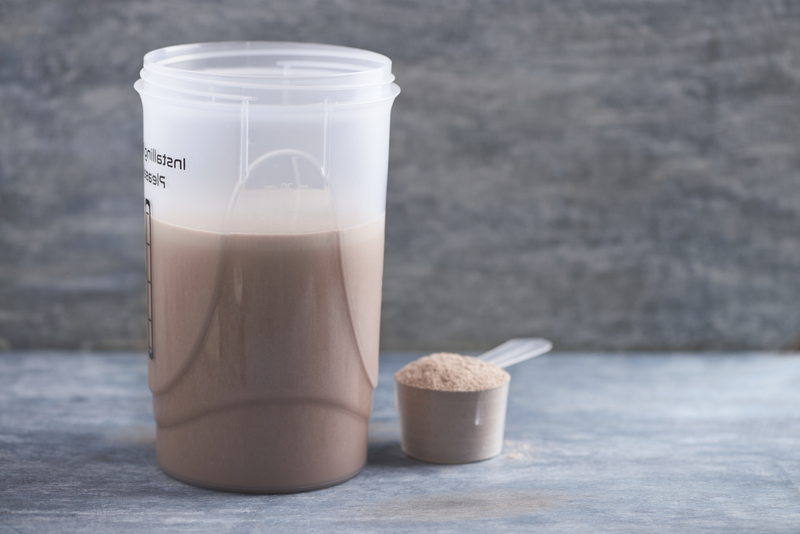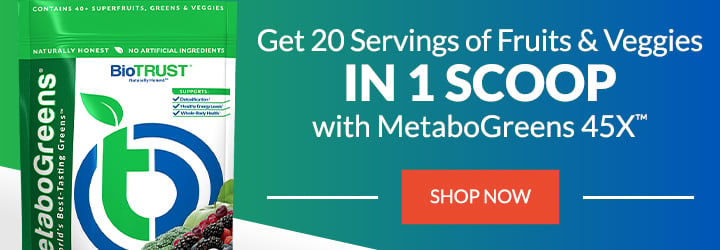Most Meal Replacement Shakes Are Trash…Here’s Why

When it comes to healthy eating, there are numerous reasons to eat a higher-protein diet. It can help you lose weight, control appetite, feel more full and satisfied, reduce cravings, maintain (or better yet, increase) muscle mass, support a healthy metabolism, maintain blood sugar within a normal range, and optimize fat loss. Not surprisingly, millions of Americans are signing up.
There’s no easier way to get the protein you need than by eating “fast food.” No, not by hitting your nearest drive-thru. Instead, whip up a protein-rich meal replacement powder (MRP) to get 15 to 30 grams of protein fast. Consume that rather than a calorie-, carb-, and fat-laden, highly processed fast-food meal, and you’re guaranteed results. Or not.
Unfortunately, many meal replacement shakes are trash—little to no better than the junk food they’re replacing. While they may or may not come at the same caloric expense, it’s true: Many MRPs aren’t much better than the fast-food meal you bypassed by skipping the drive-thru.
Many Meal Replacement Shakes Are Trash…Here’s Why
Meal replacement shakes are designed to replace a meal—typically breakfast and/or lunch. Studies have found that liquid meal replacements, when incorporated into a low-calorie diet, can indeed lead to greater weight loss than just dieting alone. 1 With millions of people eager to drop some pounds, lose some inches, and simply become smaller humans, product manufacturers realize the appeal and offer liquid solutions to “help,” often making promises that can be incredibly enticing.
Meanwhile, believe it or not, many people find it difficult to consume all of the calories they need to gain muscle mass, and a higher protein meal replacement shake can be an easy, convenient vehicle to shuttle in some extra protein, calories, and nutrients. Even more, some use meal replacements almost as a multivitamin to ensure they get the nutrients they may need to sustain their busy lives.
Most of all, meal replacements are used as an easy, convenient way to support an overall healthy lifestyle and eating practices—especially for those who have jam-packed schedules or are often on the go.
Unfortunately, far too many of these meal replacements use cheap proteins, fillers, added sugars, artificial sweeteners, and more to make a fake Frankenfood that provides little to no real nutrition. These products can leave consumers hungry, craving real food, and unhappy with their results, with the only thing getting any lighter being their pocketbook.
Here are some of the worst ingredient offenders commonly found in many meal replacements:
- Sugar, which is often listed in the top three ingredients of meal-replacement products found on shelf at your local grocery, convenience, or superstore
- Refined carbs, such as corn syrup, dextrin, or maltodextrin (from corn), which provide no nutritional value and are no better (possibly worse), metabolically speaking, than sugar
- Artificial flavors and colors
- Artificial sweeteners, such as sucralose and aspartame, which can disrupt the gut microbiome and leave you craving other sweet foods
- Poor-quality vegetable oils, which are refined, bleached, and deodorized, that may contribute to an unhealthy fatty acid profile and unhealthy levels of inflammation
- Chemical preservatives and additives
- Contaminants, including heavy metals and BPA
- Cheap protein fillers, high-heat-treated proteins, and lower quality proteins, such as brown rice or soy protein
- Residual growth hormones, antibiotics, pesticides, GMOs, and more from factory-farmed animals that are injected with synthetic hormones and antibiotics and fed GMO grains like corn and soy (rather than being grass fed)
It’s not just what’s in a meal-replacement product that determines quality but also how they’re manufactured. Many low-quality MRPs are processed with high-heat or acid treatments that result in poor-quality, denatured proteins.
Fortunately, not all meal replacements are equal, and there are better options available.
How to Find a Quality Meal Replacement Shake
A quality meal replacement shake typically provides a combination of macronutrients (i.e., clean protein, carbs, and fat) and micronutrients (i.e., vitamins and minerals) to provide energy, nutrients (including antioxidants and fiber) to keep you satiated, help balance blood sugar, and support the microbiome and digestion—just as a quality whole-food meal would.
When you’re looking at the nutrition label of any meal replacement shake, here are some of the nutrients to look for:
- At least 20 grams of protein with a complete amino acid profile, such as whey, casein, milk concentrate, or a blend of plant proteins that provides all of the essential amino acids. If you are choosing a meal replacement made from dairy, look for one that comes from grass-fed, pasture-raised, humanly treated cows. It’s also important to consider how the protein is processed. Milk proteins that are cold-processed ensure a higher quality, undenatured source of protein.
- A carbohydrate source that is at least 30% fiber, including prebiotics, such as inulin, to help feed and support a healthy gut microbiome.
- Quality fats to help keep you full.
- A natural digestive enzyme blend to help the body better digest and absorb the protein as well as support digestive health.
- Non-sugar natural sweeteners such as stevia, erythritol, and oligosaccharides.
- An appropriate amount of calories to support your health and fitness goals.
Many quality meal-replacement products are calorie-conscious, so they are appropriate for a wide range of people. Yet, if they are too low on the calorie spectrum for you, you can find yourself getting hungry before it’s time to eat your next meal, especially if you’re more active or have a faster metabolism.
If you need more calories, you can combine your meal replacement shake with a green drink (e.g., MetaboGreens), add additional vegetables and fruits (such as spinach, kale, and a handful of berries), or even add some nuts (e.g., walnuts), seeds (e.g., hemp, chia), or quality fats (e.g., coconut oil). Perhaps surprisingly, frozen zucchini, cauliflower, sweet potato, squash, or avocado can all make a standard meal-replacement shake even creamier while boosting the nutrition.
Watch the calorie count, though. When dressing up a meal replacement shake, it’s easy to push the calories upwards of 1,000 or more by adding scoops of nut butters, tons of fruits, and other calorie-dense foods. So, watch the portion sizes and/or choose one of Coach Cristina’s shake recipes to prevent yourself from going overboard.
Benefits of a Quality Meal Replacement Shake
A quality meal replacement shake can be a good option to help keep your eating plan on track, especially when life gets busy or you’re on the go. At best, it’s a convenient, fast, hassle-free meal option—one that can be quite healthy and also provide a delicious dose of versatility.
Nutrient-rich MRPs can prevent you from going too long without food, which isn’t necessarily a problem unless it leads to subsequent overeating and poor food choices. If you find yourself so focused on other tasks that you eat mindlessly, MRPs can help you better control your nutrition, calories, and portion sizes.
If you’re having trouble getting the scale to budge, meal replacement powders can be an incredibly powerful tool. While controlling your portion sizes sounds good on paper, research shows that many folks notoriously underestimate how much they’re eating, and that can thwart weight-loss efforts. Combining one or two daily MRPs with a healthy eating plan can make a big difference when it comes to controlling caloric intake, and ultimately, the battle of the bulge.
That said, if you want to lose weight or build a better body, it’s not enough to rely on a quality meal replacement shake alone and think all is good. Even if you get the absolute best of nutrition from your high-protein, carb-controlled shake, you still need to fill in the gaps with quality whole-food nutrition, including plenty of fiber- and nutrient-dense vegetables and fruits, proteins (like meats and poultry as well as plant-based proteins like beans, lentils, nuts, and seeds), whole grains, and healthy fats (like avocados, nuts, butters, and unrefined oils).
It’s also important to learn how to prepare a healthy meal with real foods rather than relying solely on ready-made products. Learning to eat right is a skill that takes practice. (Fortunately, there are hundreds of tasty recipes right on this site to help expand your healthy cooking abilities.)
Of course, drink plenty of water (at least eight 8-ounce glasses of water), get quality sleep, stay active with regular exercise (such as walking daily for 30 to 60 minutes and incorporating weight training and stretching into your weekly routine), and spend time outdoors in nature.
In other words, whether you’re consuming meals rich in healthy whole foods or using a quality meal-replacement product to save you time and money, building a lean, healthy body takes a consistent commitment to an overall healthy lifestyle to create lasting change.
A quality meal-replacement product can help (a lot), but be on the look out for wolves in sheep’s clothing. Many MRPs are trash and are little or no better than a typical fast-food meal. You and your health deserve better!







